CONVERSION OF MERCEDES TO BIO FUEL AT AWH |
||||||||||||||
After conducting initial research in both the Philippines and the U.S. pertaining to converting diesel engines to using vegetable oil (preferable used cooking oil) as fuel, I decided to take the first steps in actually converting a car. Since I brought a LoveCraftBioFuels conversion kit acquired in California to the Philippines in 2007, the choice of a car to convert was unfortunately limited to its specifications, which are Mercedes Benz 240D or 300D Diesel 1978 - 1985. I researched the web and also inspected cars offered by dealers but it still took almost three months to finally find a good car in Manila. Cars imported to the Philippines are more expensive than in the U.S. because they are often customized for this tropical, humid climate and also have a high import tax mark-up. There were no bargains to be found since the peso had also increased in value by 20% since 2007 in relation to the dollar. However, I found 1984 Mercedes 300SD in good condition but paying more than I expected. At first I hesitated a bit to use such a car for my first experiment of bio fuel conversion. However, I stayed the course to do even a little bit to protect the environment since the car would run on recycled cooking oil, thereby reducing dependency on fossil fuels.
April 19th, 2008 was the day to be commemorated as the Jolan Licauco's mechanic team came in the morning and completed the installation in the evening. It took longer than we estimated as we were filtering used cooking oil at the same time and the car battery also died during the test. When the conversion was completed we poured 10 litters of brand-new palm oil into the tank. While there was some diesel remaining in the tank Jolan told me it was okay to blend vegetable oil with diesel in such a way and that using 100% diesel was also okay even after the conversion. This was good news as I might need to use diesel on the road in an emergency.
We tested the car and it ran very well on palm oil. However the engine rattled and was also shaking a bit when the car stopped and idled. This could be attributed to the thick palm oil. The next challenge was to filter the used cooking oil. Nearby Taal Vista Hotel, being supportive of environmental causes, had kindly agreed to supply us their used cooking oil at no cost for our research. In California, restaurants and hotels generally have to pay vendors to dispose of used cooking oil and therefore it may be more readily available for free. However, in the Philippines, farmers and hog raisers buy used cooking oil as catalyst for feed. While it is not permitted, street food vendors also buy it and re-use used coking oil for frying fish balls, etc. as it is cheaper than buying virgin oil. However, even as a feed supplement used cooking oil is not cheap in the Philippines as it also increases in price as the price of diesel increases. For example the price for used cooking oil was 23 pesos per liter 2 years ago. It increased to 27 pesos per liter last year and now it is 35 pesos per liter! We are fortunate to get it still for free.
In addition to finding used cooking oil another challenge we faced was refining it. The oil we had obtained from the hotel contained a high percentage of emulsified solids so that the first batch of oil we tried to filter almost broke the centrifuge and filtration system that Jolan fabricated. The partially refined oil became too foamy and creamy which related to higher pressure within the filtration system comparable to clogged arteries. The first batch therefore failed and we had to dispose of it. Upon Jolan's recommendation we prefiltered the next batch with pillow cases. While it took all night, this new method filtered out the oil sludge effectively. Encouraged, we pre-filtered another 2 containers the same way. However, after the removal of sludge and solids the oil was reduced to one-third of its original volume because we ended up with only about 20 liters of potential fuel oil after filtering and refining 60 liters of used cooking oil.
The next major step was to separate water and further sediments from the filtered oil by centrifuge. For this step the filtered oil was allowed to sit for a couple of days which allowed further sediments to settle to the bottom. The oil was then scooped from the surface and relocated into a drum for further processing. This drum has a hole in its bottom from which the oil is sucked and pumped into the centrifuge chamber. The centrifuged oil and residual oil are then circulated back into the drum. This took about eight hours. After running the centrifuge for about one to two hours the centrifuge chamber had to be opened, the separated water had to be removed and the chamber cleaned. After a while we realized that the two tiny holes in the centrifuge had to be periodically cleared with an air pressure hose as the holes would clog up with small debris from the first batch of many solids. After performing such maintenance the time for centrifuging was cut in half as 20 liters of oil were centrifuged in four hours. This brought us to the final stage namely the filtration through a 0.5 micron filter. This took only half an hour.
The next morning we pumped the filtered oil into the tank of the Mercedes for the first time. It ran as good as the brand-new palm oil. I felt great and thought it was worth the effort as we did it for the environment! The emission did not smell petroleum-like. Ours may be one of the first cars in the Philippines which uses SVO (straight vegetable oil) as fuel. But this is just a beginning. Many busses, trucks and jeeps are poorly maintained and are extensively polluting the environment by belching black smoke everyday, thereby leaving also a huge carbon footprint. We have to find alternate fuel but still have a long way to go!
Report made in April 2008 by Casey Takayama |


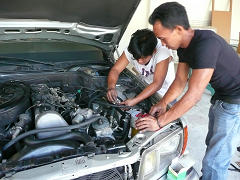
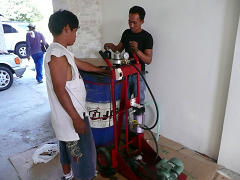



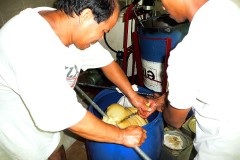
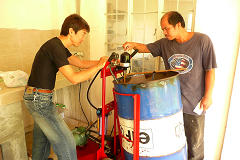

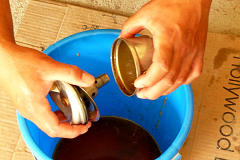
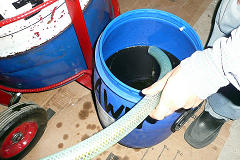
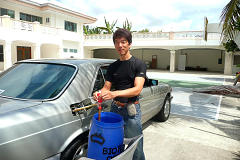 At last we had produced 20 liters of filtered WVO (waste vegetable oil). Was it worth the effort? How much energy did we expand?
At last we had produced 20 liters of filtered WVO (waste vegetable oil). Was it worth the effort? How much energy did we expand?